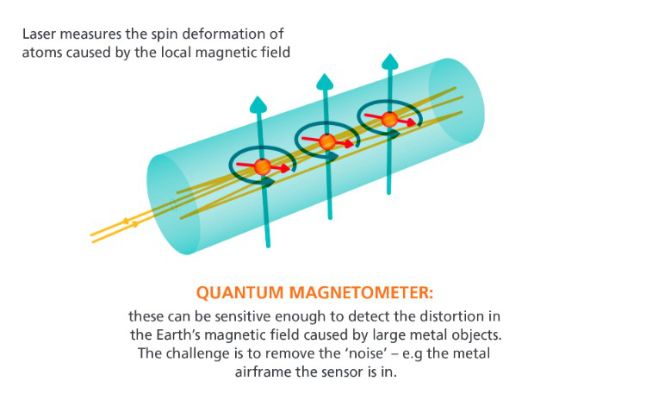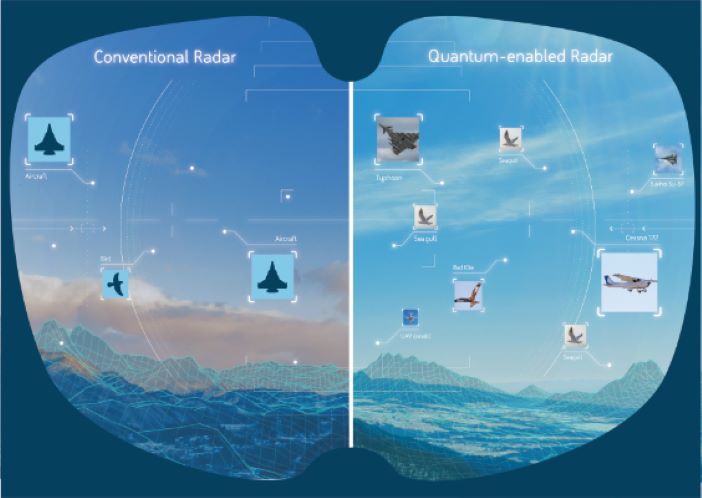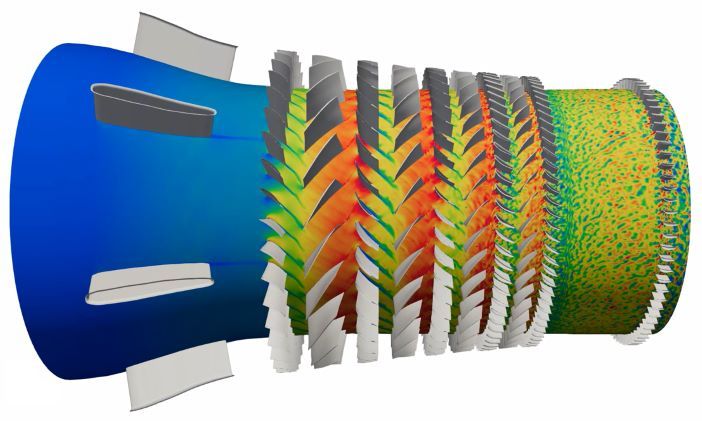Jamming and spoofing of satellite navigation signals represent a threat to both military and civilian aircraft. To prevent such occurrences, the UK Government is funding an £8 million (US$10 million) R&D program to investigate spoof-proof navigation technology. The program is part of an overall £2.5 billion (US$3.2 billion) National Quantum Strategy and Technologies Program.
The aim of the program is to develop technology that prevents the spoofing and jamming of global navigation satellite systems (GNSS), and it involves the flight testing of “a quantum-based navigation system,” using QinetiQ’s RJ100 airborne technology demonstrator. It was equipped with a Tiqker optical atomic clock and an ultra-cold-atom-based quantum system.
Navigation motivations
Dr Derek Craig, deputy director for cross-council programmes at the UKRI Engineering and Physical Sciences Research Council explains the motivation behind investments in quantum-based navigation systems. He says, “Positioning, navigation and timing [PNT] has critical importance across national infrastructure, navigation and communications networks. Current PNT solutions are typically reliant on GNSS, but there are significant robustness and resilience challenges for these existing systems.”
Quantum PNT provides opportunities for navigation where GNSS is not a feasible solution, such as underground or underwater. “It has the potential to unlock market opportunities and performance improvements, which will allow us to meet challenging new requirements and applications,” Craig says.
Douglas Paul, professor of semiconductor devices at the James Watt School of Engineering, University of Glasgow, is the UK Hub for Quantum Enabled Position, Navigation and Timing’s (QEPNT’s) principal investigator. He says, “Quantum technologies harness quantum physics to gain a functionality or performance which is otherwise unattainable. It involves the use of quantum technology sensors for improving the performance of inertial navigation systems, geo-location systems and hold-over clocks.
“Quantum sensors can be used in dead-reckoning navigation systems – where you are using time inertial sensors, measuring speed, velocity, and attitude. It’s also about measuring signals of convenience, such as geo-location using magnetic fields. Examples of other sensors include co-magnetometers gyroscopes.
“This is a new type of compass and they can be as accurate as a physical-sized gyroscope, but at a fraction of the size, weight, power and cost.”
Photon lidar systems are also being developed for aircraft landing. Paul says that his team is already working on these systems with aerospace and defence company Thales as part of another UK Government funded research project. Photon lidar systems have a 5km (3.2 miles) ranging ability at eye-safe power levels and can provide significant improvements over present ranging systems through obscurants such as cloud, rain, fog, mist and dust.
There also hybrid systems, which use the best properties of quantum and classical sensors in combination with each other. Paul says, “Many classical systems have faster measurement bandwidth but poor drift, whilst quantum sensors have excellent low drift but slow measurement bandwidth.
“Combining the two enables fast measurement bandwidth and the ability to remove the drift from classical sensors through recalibration.”

Quantum flight testing
Despite recent reports of the advanced state of flight testing of quantum-based navigation systems using QinetiQ’s RJ100 flying testbed, Paul believes that its use is a long way off. Nevertheless, there are GNSS-denied environments available at Sennybridge military training area in the UK. The Royal Navy has offered Hercules aircraft to run [quantum] systems in parallel to their standard navigation systems. Airbus, BAE, QinetiQ, Thales and Leonardo are all partners with interests in flight-based PNT systems.
Emmanuel Robert, head of R&T programs for inertial navigation at French firm Safran Electronics and Defense says, “Most experts in this domain consider that a possible introduction for quantum technologies is more than 10 years away. More flight tests will happen in the coming years to field-prove this solution.”
Safran has decided to focus development on its hemispheric resonator gyroscope (HRG) technology because quantum-based technology is not mature enough. The firm claims that HRG is having a real impact on the navigation market worldwide by “bringing a new level of performance in a miniaturized form.”
In contrast, Robert believes quantum-based navigation systems will take at least 15 years to reach the commercial market. However, his company Safran believes it is sufficiently viable to be involved in several projects where it is being developed.
Significant potential
Andy Proctor is director of RethinkPNT, vice president of the Royal Institute of Navigation and chair of the PNT Advisory Group. He believes the term “spoof-proof” is sensationalist because many non-GNSS navigation technologies are already available, but that there is potential to use quantum techniques in navigation systems in some sectors and markets.
Kieran Bjergstrom, director of consultants Quantum Technologies Associates, agrees that spoof-proof is a difficult term. He explains, “Emerging quantum-based navigation systems are at varying readiness levels, and some are being laboratory-tested in simulated environments – including for the maritime sector.
“Components are being tested in controlled flight trials. This represents a shift of the technology from the laboratory to integrated on-platform environments. They are being tested for operational functionality in realistic environments, and we are starting to derive performance metrics for quantum navigation systems on platforms to assess which levels of GNSS denials they can mitigate by way of providing hold over navigation.
“We are also assessing the efficacy of other types of sensors to provide position fixes, such as gravity gradiometers and quantum magnetometers.”
The use of quantum clocks is also offering new solutions, allowing for resilient timing by reducing the reliance on external signals when they are used in combination for PNT. This ensures that PNT is not degraded as rapidly by jamming.
Levels of uncertainty
Henry White, advanced sensing lead, BAE Systems warns that while quantum-based navigation systems can achieve a high level of accuracy, there will still be a level of uncertainty caused by measurement methodologies. They will cause drift and give navigation errors, so he suggests their use will be to provide hold over navigation systems while “methods that rely on external factors, such as satellite signals or map-matching data are not available.”
When satellite or map matching are available to the aircraft, the internal system can reset to use the solution that provides the longer-term accuracy that is typically required. Professor Michael Biercuk, CEO and founder of Australian quantum technology company Q-CTRL argues quantum navigation is already better than its
non-quantum counterparts. The task at hand is to take these systems out of the laboratory and into the field to deliver a strategic advantage.

(Image: BAE Systems)

Q-CTRL is developing a new generation of quantum gravimeters, magnetometers and accelerometers, which Biercuk says are powered by the quantum properties of atoms and are sensitive and compact enough to measure navigation-relevant signals on real vehicles.
However he accepts commercializing quantum technologies is challenging: “Real platforms are subject to interference, harsh conditions, and vibrations that conspire to erase the benefits we know quantum sensors can provide.”
Recent research, he says, has found that new AI-powered software can be used to deliver the robustness needed to put quantum sensors onto real moving platforms. “The right software can keep the systems functional even when they’re being shaken and subjected to interference on ships and aircraft,” Biercuk says.
Finnair: Flights canceled
As such quantum navigation systems could be used, for example, to prevent a situation as experienced by Finnair when a satellite signal was jammed. This leading to the airline temporarily suspending its daily services to Tartu from 29 April 2024.
As a consequence Estonia’s air traffic control service is looking to reinforce its navigation systems. It wants to offer an alternative to GPS navigation, which is heavily reliant on satellite communications, following the jamming of the satellite signal.
Safety first
According to White, while compromised navigation for aircraft is a very serious issue, safety will always come first and any mitigating actions will cause delays which can have knock-on effects to other planned flights and cause passenger delays and operating costs. Being able to incorporate un-jammable systems alongside traditional systems should made such occasions a thing of the past.
As for flight tests, according to Paul they will become more frequent to trial the use of quantum sensors in aircraft. It’s already happening with the Qinetiq and BAE Systems tests. The goal remains for the UK program to install quantum navigation systems, including clocks on aircraft by 2030 to provide next-generation accuracy and resilience – independent of satellite signals. With just six years to go that equates to a quantum leap, which may in reality need more than a decade to achieve.
Quantum technology takes on van man
The most likely scenario for needing quantum navigation technology is in GNSS-denied environments. The UK’s National Risk Register says there is a 5% probability of loss of GNSS due to malicious or accidental incidents, state interventions, or weather events.
The FBI prosecuted a van driver who was using a GPS jammer at the edge of Newark Airfield, New Jersey, in the USA in 2012. Dallas Forth Worth Airport had a GPS outage in October 2022 for 48 hours. The cause was never ascertained. Wisconsin in October 2022 suffered an outage where a 5G base station malfunctioned – taking two days to fix.
There is a lack of GNSS around war zones in Ukraine and Gaza. Organized crime gangs are also known to use GNSS meaconing, a form of spoofing, in people and drugs trafficking activities. There are also state threats to GNSS systems.
But the biggest threat is the everyday van or truck driver, like the person prosecuted for the GPS outage that affected Newark airfield in 2012. Employees most often use jammers to disrupt trackers that have been fitted by employers who want to track their vehicles and activity.
When they are used around airports the impact can be severe on air traffic safety. The driver may not be maliciously trying to block signals to air traffic, but inadvertently does when trying to hide themselves.
The Use of Quantum Computing In Engine Testing
Rolls-Royce uses quantum computing for computational fluid dynamics (CFD). The company says it hopes to use the technology to accelerate how to accurately model the air flow through a jet engine.
As with quantum navigation systems, the focus is on error correction. Working with its partners Xanadu and Riverlane, Rolls-Royce says its aim is to protect information from noise in the quantum computer device itself. Ultimately, they want to develop fault tolerant computers – those that prevent errors spreading during the error-correction process or during a computation.

There are also efforts to use quantum computing in wind tunnel testing. In the USA, the Defense Advanced Research Projects Agency (DARPA) has invited US companies and academic researchers to compete to design a wind tunnel under the Automated Prediction Aided by Quantized Simulators initiative. The aim is to tap into quantum properties to mimic turbulence around an aircraft and study its effects and impact on aerodynamics. Using CFD, measurements could be made under several types of conditions, which wouldn’t be possible in any physical wind tunnel.





